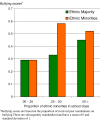Bullying and victimization among adolescents: the role of ethnicity and ethnic composition of school class
- PMID: 20091212
- PMCID: PMC2796963
- DOI: 10.1007/s10964-008-9355-y
Bullying and victimization among adolescents: the role of ethnicity and ethnic composition of school class
Abstract
The present study examined the relationships between ethnicity, peer-reported bullying and victimization, and whether these relationships were moderated by the ethnic composition of the school classes. Participants were 2386 adolescents (mean age: 13 years and 10 months; 51.9% boys) from 117 school classes in the Netherlands. Multilevel analyses showed that, after controlling for the ethnic composition of school class, ethnic minority adolescents were less victimized, but did not differ from the ethnic majority group members on bullying. Victimization was more prevalent in ethnically heterogeneous classes. Furthermore, the results revealed that ethnic minority adolescents bully more in ethnically heterogeneous classes. Our findings suggest that, in order to understand bullying and victimization in schools in ethnically diverse cultures, the ethnic background of adolescents and the ethnic composition of school classes should be taken into account.
Figures
Similar articles
-
Individual and contextual factors associated with patterns of aggression and peer victimization during middle school.J Youth Adolesc. 2013 Feb;42(2):285-302. doi: 10.1007/s10964-012-9854-8. Epub 2012 Nov 17. J Youth Adolesc. 2013. PMID: 23160659
-
Ethnic density in school classes and adolescent mental health.Soc Psychiatry Psychiatr Epidemiol. 2010 Jun;45(6):639-46. doi: 10.1007/s00127-009-0105-6. Epub 2009 Aug 5. Soc Psychiatry Psychiatr Epidemiol. 2010. PMID: 19655079 Free PMC article.
-
Bullying and minorities in secondary school students in Thrace-Greece.Am J Orthopsychiatry. 2018;88(4):462-470. doi: 10.1037/ort0000281. Epub 2017 Nov 27. Am J Orthopsychiatry. 2018. PMID: 29172556
-
Taking peer victimization research to the next level: complex interactions among genes, teacher attitudes/behaviors, peer ecologies, & classroom characteristics.J Abnorm Child Psychol. 2015 Jan;43(1):77-80. doi: 10.1007/s10802-014-9948-8. J Abnorm Child Psychol. 2015. PMID: 25345834 Review.
-
Approach to bullying and victimization.Can Fam Physician. 2009 Apr;55(4):356-60. Can Fam Physician. 2009. PMID: 19366941 Free PMC article. Review.
Cited by
-
Ethnic Bullying Victimization in Italy: The Role of Acculturation Orientation for Ethnic Minority Adolescents With Differing Citizenship Statuses.Front Psychol. 2020 Mar 19;11:499. doi: 10.3389/fpsyg.2020.00499. eCollection 2020. Front Psychol. 2020. PMID: 32265799 Free PMC article.
-
Discriminatory Climate and School Adjustment in Ethnically Minoritized Adolescents and Majority Adolescents: An Investigation of the Mediating Role of Teaching Quality.J Youth Adolesc. 2025 Jul;54(7):1732-1755. doi: 10.1007/s10964-025-02147-2. Epub 2025 Feb 7. J Youth Adolesc. 2025. PMID: 39918709 Free PMC article.
-
For Better or Worse: Friendship Choices and Peer Victimization Among Ethnically Diverse Youth in the First Year of Middle School.J Youth Adolesc. 2016 Sep;45(9):1862-76. doi: 10.1007/s10964-016-0516-0. Epub 2016 Jun 6. J Youth Adolesc. 2016. PMID: 27272516 Free PMC article.
-
School bullying and minority identity as a menace to mental well-being of students in Greece.BJPsych Int. 2021 Aug;18(3):60-63. doi: 10.1192/bji.2020.51. BJPsych Int. 2021. PMID: 34382951 Free PMC article. Review.
-
Not just black and white: peer victimization and the intersectionality of school diversity and race.J Youth Adolesc. 2015 Jun;44(6):1241-50. doi: 10.1007/s10964-014-0243-3. Epub 2014 Dec 19. J Youth Adolesc. 2015. PMID: 25524495
References
-
- Coenders M, Gijsberts M, Hagendoorn L, Scheepers P. Introduction: Nationalism and exclusionist reactions. In: Gijsberts M, Hagendoorn L, Scheepers P, editors. Nationalism and exclusion of migrants: Cross-national comparisons. Aldershot: Ashgate; 2004. pp. 1–25.
-
- Cohen EG, Lotan R, Catanzarite L. Treating status problems in the cooperative classroom. In: Sharan S, editor. Cooperative learning: Theory and research. New York, NY: Praeger Publishers; 1990. pp. 203–229.
-
- DioGuardi RJ, Theodore LA. Understanding and addressing peer victimization among students. In: Jimerson SR, Furlong M, editors. Handbook of school violence and school safety: From research to practice. New Jersey: Lawrence Erlbaum Associates Publishers; 2006. pp. 339–352.
MeSH terms
LinkOut - more resources
Full Text Sources
Medical



